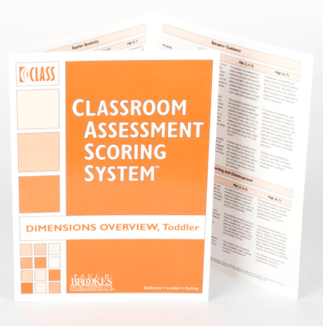
CLASS observers have a limited arsenal when it comes to conducting observations and assigning scores: CLASS score sheets for noting and sorting evidence, and the CLASS manual for guidance when choosing scores. These two items (along with a trusty writing utensil and an up-to-date CLASS certification) are the only pieces of equipment that are truly necessary for success. Tucked neatly in the back of the manual, however, lies an additional resource that is the most controversial of them all: the CLASS Dimensions Overview--you might know it as "the laminated tri-fold."
 The laminated tri-fold (or in the case of the Infant CLASS tool, the bi-fold) is essentially an amalgamation of the face pages for every dimension, conveniently assembled for easy reference. For each dimension, the tri-fold lists all of the indicators and behavioral markers, along with the brief low, mid, and high range descriptions from the face pages in the manual.
The laminated tri-fold (or in the case of the Infant CLASS tool, the bi-fold) is essentially an amalgamation of the face pages for every dimension, conveniently assembled for easy reference. For each dimension, the tri-fold lists all of the indicators and behavioral markers, along with the brief low, mid, and high range descriptions from the face pages in the manual.
Sounds great, right? Right!
What an easy way to code, right? Wrong!
What the “tri-fold” IS good for
The tri-fold is great for learning the tool--familiarizing yourself with what types of behavioral evidence fit into each indicator, and which indicators fall into which dimensions. It can also be used as a reference while watching training videos and taking notes--scanning over the tri-fold briefly as a video plays can remind an observer what types of interactions to look for and where to note them. Using the tri-fold this way can prevent the paralysis that happens to most new CLASS observers when they see or hear something in a training video and think to themselves, “Aha! That’s evidence ... of ... something! But I have no idea what!” A quick glance at the tri-fold might help the observer to decide that the open-ended question they just heard should be noted in Language Modeling rather than Quality of Feedback, for example.
When NOT to use the “tri-fold”
The tri-fold loses its usefulness, however, when used for the actual coding process. As any CLASS trainer worth their salt knows, the coding process can’t take place without the use of the detailed descriptions of the low, mid, and high ranges that only exist in the manual. Because the behavioral markers within a dimension aren’t intended to be used as a checklist, and because the brief low, mid, and high descriptions on the face page or in the tri-fold are, well, brief, we have to use the descriptive pages to differentiate between ranges when scoring.
How do you manage your Observation participants’ excitement over the “tri-fold”? Join the trainer group on Facebook to discuss this and other controversial training topics with fellow CLASS trainers!

